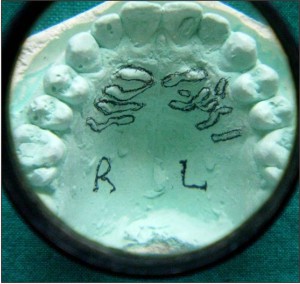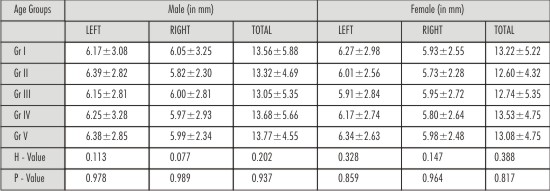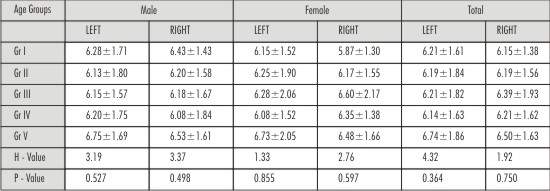Introduction
Forensic Odontology or Forensic Dentistry is that branch of forensic medicine which in the interest of justice deals with the proper handling and examination of dental evidence and with the proper evaluation and presentation of the dental findings.[1] It has three major areas of utilization: (1) diagnostic and therapeutic examination and evaluation of injuries to jaws, teeth, and oral soft tissues, (2) the identification of individuals, especially casualties in criminal investigations and/or mass disasters, and (3) identification, examination, and evaluation of bite marks which occur with some frequency in sexual assaults, child abuse cases, and in personal defense situations.[2]
Human identification has become fundamental in all aspects of human relationships, at both social and legal levels. It allows people to preserve their rights and have their duties demanded from both civil and legal standpoints. Identification corresponds to a combination of different procedures to individualize a person or an object.[3]
Most positive identifications today are based on Dental examinations and Fingerprints and these are fundamental procedures in medicolegal death investigations including mass disasters. However identity cannot always be conclusively established by one particular method. In instances where the more common modes of identification fail to be used, other methods gain significance.[2] Unfortunately there have been fewer projects designed to investigate the usefulness of’ oral soft tissues in forensic investigations. For centuries, anatomists have shown interest in the evolutionary development of the folds of tissue found in the roof of the human mouth- the palatal rugae. Winslow (1732) [4] suggested that the pattern of' rugae might be unique and simple. Harrison Allen (1889) first suggested use of human palatal rugae as an alternative method of identification.[5]
Palatal rugae are known as plicae palatinae transverse and rugae palatina, refer to the ridges on the anterior part of the palatal mucosa, each side of the median palatal raphe and behind the incisive papilla.[6] The study of the palatal rugae patterns termed as palatoscopy also known as “Rugoscopy”. The pattern of the rugae is unique and individualistic and can be used in identity fixation. The rugae have been equated with finger prints and likewise display total individuality. Rugae are protected from trauma by their internal position in the head and they are insulated from heat by the tongue and the buccal fat pads.[7] Even between twins, the studies indicated that the patterns are similar but not identical.[8]
The Palatal rugae study has a potential role in identification is consequently obvious and has occupied the minds of research workers for many years. The increase in travel, particularly by air and resultant disasters makes the recording of rugae pattern important.[8]
Although a number of studies have been performed on Rugoscopy, very few were done involving the North Indian population. The present study is aimed to fill this lacuna. In addition, the comparison of palatal rugae patterns with age groups is also performed to see if there is any correlation between the two, as this aspect could prove to be a valuable step towards the identification of an individual.
Materials & Methods
Study Population
The present study was conducted on 400 subjects after approval by local ethical committee and study groups were divided into 5 age groups as – Group I (11-15years), Group II (16-20 years), Group III (21-25 years), Group IV (26-30 years) & Group V (31-35 years). Each study group comprised of 40 subjects each in males & females.
Study Design
After obtaining informed consent, alginate impressions of maxillary arch was made & casts were preserved for interpretation. The outline of rugae was traced using 0.5mm fine lead pencil (Fig. 1).The rugae were analyzed on the basis of Shape, Length & Number. The data for the right & left sides were analyzed separately.
(A) Shape Analysis: The shape of the palatine rugae was registered according to the classification of TROBO (Table 4). This classification divides rugae into two groups: Simple rugae, classified as A, B, C, D, E & F where rugae shapes were well defined and Composed rugae, classified as type X, with a polymorphisms variety (these rugae result from the union of two or more simple rugae). An extra type NS (not specified) have been included in the classification by us to categorize the rugae which did not fall into any of above types.
(B) Size Analysis: The length of each rugae was measured using a digital vernier caliper & classified as primary, secondary & fragmentary according to LYSELL.[4] The straight rugae were measured for maximum longitudinal length whereas, the circular, curved, sinuous & angle shapes were measured by breaking the rugae at each curvature & then adding up length at each curvature to make up the total length of rugae.
(C) Number Analysis: The numbers of palatal rugae were counted on right and left sides for each subject.
 | Figure 1 : Outline Of Palatal Rugae Traced On Maxillary Cast.
 |
 | Table 4: Trobo’s Classification For Determining Palatal Rugae Shape.
 |
The rugae size less than 2mm were not considered for the size & number analysis.
Statistical Analysis
The comparison between age groups for rugae shape as well as rugae number was done using Kruskal Wallis (H) test & for rugae length was done using One way ANOVA (F) test. A p-value of 0.05 was considered as a set point. Statistical analysis were performed using SPSS software version 11.5.
Results
Palatal rugae patterns have shown population specific tendencies. So the results of present study are specific for North Indian population (Mathura, U.P). Results were obtained (Tables:1-3) under each parameter as:
1. Most & least prevalent Shape of palatal rugae in all the age groups
2. Prevalence of Non specified shape in total sample population
3. Maximum & minimum mean length of rugae in all age groups
4. Comparison of rugae length between the age groups
5. Maximum mean number of rugae in all the age groups
6. Comparison of rugae number between age groups
 | Table 1:Prevalence & Comparison Of Palatal Rugae Shapes Between Age Groups.
 |
 | Table 2:Comparison Of Mean Rugae Length Among Genders & Sides In Different Age Groups.
 |
 | Table 3:Comparison Of Mean Palatal Rugae Number Between The Age Groups.
 |
Statistical analysis showed the most prevalent (41.2%) shapes among all the subjects were found to be Type E (Sinuous) & the least prevalent (1.14%) shape were found to be Type F (Circle). The non specified shape i.e. Type NS had a prevalence of 2.7% in total study population. On comparing prevalence of each rugae shape between all the study age groups highly significant (p<0.05) differences were found to exist. Maximum length of rugae was observed in Group IV (13.60mm)& Maximum length of rugae in males & females was observed in Group V (13.77mm) & Group IV(13.53mm) respectively. On comparing mean rugae length between left & right sides among Males & Females of all age groups statistically no differences were found (p>0.05). Maximum number of rugae was found in Group V. Though statistically no significant (p>0.05) variations exist in the rugae number in left & right of males & females, but females on left side found to be slightly higher in number of palatal rugae.
Discussion
The unique individual nature of the human body is reflected in such structures as finger prints, lip folds, palm prints, retina and the palatal rugae. This individuality and the exposure in the body which allows observation and recording has caused these structures to be implicated in forensic science and to become important in identification.[8] When traffic accidents, acts of terrorism or mass disasters occur in which it is difficult to identify a person solely from the finger prints or dental records, palatal rugae may be an alternative method of identification.[9]
In the field of forensic odontology, Palatoscopy or Rugoscopy is still in its infancy as till date the study of palatal rugae has not been extensive. Although palatal rugae appear to possess the features of an ideal forensic identification parameter as uniqueness, postmortem resistance & stability.[10] Hence palatal rugae can be used in postmortem identification provided an ante mortem record exists.
Apart from problems in recording different rugae patterns, there is no doubt that even greater discrepancies could exist between observers/researchers. Although many researchers have confirmed the potential value of rugae in personal identification, it is important that exact reproductions of patterns (for example, casts or photographs) are available and that classification systems are further refined so that they are reliable but relatively simple to apply. [11]
Many classification systems of palatal rugae are known today which are named on authors who proposed them. These include - Goria , Carrea , Martins dos Santos, Lopez de Leon, da Silva, Trobo, Basauri, Comoy, Correia , Lysell, Kapali, Thomas & Kotze, Lima, Caruso, Tzatscheva and Jordanov. Due to the clear lack of uniformity in nomenclature of different classification systems, it becomes more difficult to compare the results with previous literature.
In the previous literature,[6] sinuous (Type E) palatal rugae shape documented as most prevalent. Least prevalent rugae shape was circular (Type F). In the present study, we found similar findings. The non specified shape i.e. Type NS had a prevalence of 2.7% in total study population. These findings are in accord with previous results where some non specific rugae shapes were observed & such a finding provides scope for describing new rugae patterns.
Previous literature documented that all individuals showed change in shape of at least one rugae with increasing age.[11 These findings suggests that with advancing age the prevalence of rugae shapes gets changed & also similar rugae shapes were not to be seen on both sides & among the genders. In our study, on comparing each rugae shape between all age groups among males & females of left & right side highly significant variations were found. These findings proves that differing age groups in Mathura population show variations in palatal rugae shapes, as this aspect could be helpful towards identification of an unidentified individual.
As literature states that rugae length increases with age in both genders.[4],[12] In the present study maximum length of rugae in males was observed in Group V & in females in Group IV. This concludes that more rugae length is present in higher age groups in both sexes. The possible explanation for such a finding would be if rugae development is coordinated with differential growth of the palate. This also supports the statement that once rugae development is over, only possible changes in palatal rugae length occurs due to normal growth & remains on same position throughout life of a person.[12] Bilateral symmetry in rugae length exists between both sexes on comparing mean rugae length among all age groups irrespective of left & right sides of palate. These findings suggest that length characteristics of rugae lack the discriminatory ability.
Previous findings report that rugae remain fairly stable in number except when there is trauma (loss of teeth or persistent pressure which may modify the alignment) or at late ages.[14] whereas our study showed maximum numbers of rugae were found in Group V on both sides, thus we can hypothesize that more number of rugae present in higher age groups. Trends in the number of rugae in different human populations suggest a tendency for greater rugae development qualitatively & quantitatively in populations with broader palates as in males. Our contradictory findings (i.e more rugae in females) may be merely due to the method of categorizing length measurements rather than analyzing direct measurements.
In our study we observed more number of rugae on left side & it might be due to the phenomenon of regressive evolution dominating the right side of palate.[12],[15]
Conclusion
It is beyond doubt that palatal rugae are unique to an individual. Thus, the analysis of palatal rugae combined with other methods, is an important alternative and complementary technique for human identification thereby providing a significant contribution in forensic investigations. The palatal rugae patterns will be of great use in the future of forensic odontology. It would be beneficial to conduct further studies with larger samples & include other parameters for palatal rugae analysis in all the races of Indian population so that a national data base could be prepared.
References
1. Keiser- Neilsen S. Person Identification by Means of Teeth. John Wright & Sons, Bristol; 1980:668-81.
2. Wagener GN. Scientific methods of identification. Stimson GP. Forensic Dentistry.CRC Press;1997:16-19.
3. Filho IEM, Sales-Peres SDC, Sales-Peres A, Carvalho SPM.Palatal rugae patterns as bio indicators of identification in Forensic Dentistry. RFO 2009; 14:227-33.
4. Winslow JB. Exposition Anatomique de la structure du corps humain. Cited by: Lysell L. Plicae palatinae transversae and papilla incisive in man. Acta Odontologica Scandinavica 1955; 13:18.
5. English WR, Summit JB, Oesterle LJ, Brannon RB, Morlang WM. Individuality of human palatal rugae. J Forensic sciences 1988; 33:718-26.
6. Venegas VH, Valenzula JSP, Lopez MC, Galdames ICS. Palatal RugaeS Systematic Analysis of its Shape and Dimensions for Use in Human Identification. Int J Morphol 2009;27: 819-25.
7. Fahmi FM, Sharmani SMA,Talic YF.Rugae pattern in a Saudi population sample of males and females. Saudi Dental Journal 2001; 13:92-95.
8. Thomas CJ, Kotze TJW, Nash JM. The Palatal Rugae in Forensic Odonto-stomatology. J Forensic Odonto- stomatology 1983; 1:11-18.
9. Patil MS, Patil SB, Acharya AB. Palatine rugae and their significance in clinical dentistry JADA 2008; 139:1471-78.
10. Nayak P, Acharya AB, Padmini AT,Kaveri H. Differences in the palatal rugae shape in two populations of India. Archs Oral Biol 2007; 52:977-82.
11. Kapali S, Townsend G, Richards L, Parish T. Palatal rugae patterns in Australian Aborigines and Caucasians. Australian Dental Journal 1997; 42:129-33.
12. Simmons JD, Moore RN, Erickson LC. A Longitudinal Study of Antero-posterior Growth Changes in the Palatine Rugae. J Dent Res 1987; 66:1512-15.
13. Almeida MA,Phillips C, Kula K., Tulloch C.Stability of the palatal rugae as landmarks for analysis of dental casts.Angle Orthodont 1995;65:43-8.
14. Hauser G,Daponate A,Roberts MJ.Palatal Rugae.J Anat 1989;165:237-49.
15. Dohke M, Osato S.Morphological study of the palatal rugae in Japanese. Bilateral differences in the regressive evolution of the palatal rugae. Jpn J Oral Biol 1994; 36:126-40.
|